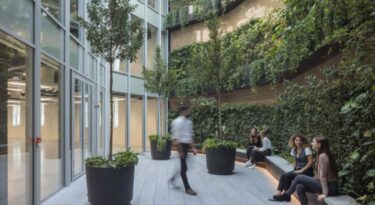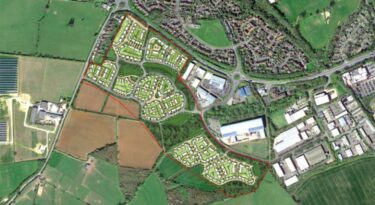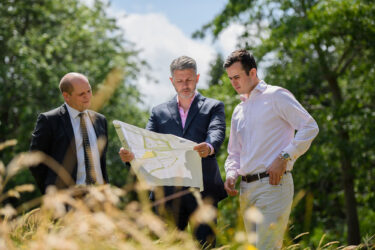Biodiversity in the UK is under severe and urgent threat.
In the words of the UK Green Building Council (UKGBC), alongside the climate crisis, we are facing an ‘ecological crisis’. Even though 78% of the UK’s assets are linked to natural capital, the UK is one of the most biodiversity-depleted countries in the world. Restoring our natural environment is therefore critical to building our future green economy.
The UK government has recognised this urgent need, which is what underpins the new legislation aimed at enhancing the sustainability of the built environment.
From February 2024, developers, landowners and local planning authorities (LPAs) must all adhere to the government’s Biodiversity Net Gain (BNG) requirement of 10%.
Alongside this, the government has set out a 25-year environment plan that seeks to make wider ‘environmental net gain’ a fundamental feature of the planning system. This approach moves a step closer with the shift to mandatory biodiversity net gain, superseding the existing National Planning Policy Framework requirement simply to provide BNG ‘where possible’.
For those wondering about the Biodiversity Net Gain definition and how it can be implemented, let’s explain where the policy has come from, how it works, and how developers can use it to work towards a greener future for Britain.
What is Biodiversity?
Before we can understand Biodiversity Net Gain’s meaning, we must first answer a more fundamental question: what is biodiversity?
Generally speaking, biodiversity refers to the variety of living things on Earth. From animals to plants, individual genes to whole ecosystems, it describes how organisms work together in the intricate networks we call ecosystems. Ecosystems vary in scale and complexity, but it is their biodiversity—the way different species interact with each other—that underpins their resilience, allowing them to survive and thrive.
What is Biodiversity Net Gain?
Biodiversity Net Gain, or BNG, is a method of approaching development that seeks to leave biodiversity in a better condition than before developments have been initiated. Specific sites across England are already protected, but up until now there have been precious few mechanisms used in mainstream planning to assess, improve or create wider habitats.
A brief history of BNG
For many years habitats have been lost or damaged as a consequence of development. The impact on natural ecosystems has been a diminishment of biodiversity, a weakening of nature’s resilience to change, and a reduction in the wider benefits those ecosystems generate for people and the wider environment.
In 1990 the UK government created the Town and Country Planning Act, which sought to regulate development in towns and counties across England and Wales. This legislation proposed, among other things, provisions for designating and protecting natural conservation areas.
In 2021, the act was amended with a specific clause—Schedule 14—put in for the delivery of mandatory BNG outcomes. A parliamentary report had previously found that 15% of UK species were facing extinction as a result of declining biodiversity.
What does the 2021 Act say?
Under Part 6 and Schedule 14 of the 2021 Act, developments must demonstrate they will meet the ‘Biodiversity Gain Objective’—the agreement that every new project delivered will achieve at least a 10% rise in biodiversity, and that this will be maintained for at least 30 years.
All development types—with a few exceptions—are subject to these statutory requirements. All planning permissions will be subject to the new rules, meaning that no projects can begin until a Biodiversity Gain Plan has been outlined. Developers must submit the plan—demonstrating how the 10% quota will be met—to the local planning authority for approval.
Why is BNG important?
Put simply, Biodiversity Net Gain is important because biodiversity is important. As biodiversity in the UK has gradually declined—leaving it the lowest-performing G7 nation—it has become vital that new developments work to enhance and create new natural ecosystems across the nation.
Climate change has also put more pressure on UK wildlife, yet if biodiversity levels are resilient it can help communities adapt to weather extremes such as heatwaves and flooding.
BNG entered law as a way to protect and preserve key habitats for the future. The 10% target in the past was optional, or even non-existent, for developers, landowners and LPAs. As a result the government had no guarantee that construction projects and other developments would meet biodiversity needs. The 2021 Environment Act now ensures that ecosystems are conserved and nurtured from here on out.
How do you measure BNG?
BNG uses habitats as a proxy for biodiversity, and describes these in terms of ‘biodiversity units’. To prove you have accurately calculated the number of biodiversity units for existing habitat, or habitat enhancements to achieve BNG, you must use the statutory biodiversity metric tool. This applies the official biodiversity metric formula to the proposed plan.
Biodiversity metric
The biodiversity metric is a formula used for measuring biodiversity across all types of habitat. The following information about habitats is fed into an algorithm, and this provides a score representing their value for biodiversity:
- Type
- Size
- Distinctiveness
- Condition
- Strategic significance
These criteria have long been a significant part of ecological assessments. However, the biodiversity metric provides a structured and consistent way of measuring them. This provides a degree of certainty regarding how a plan might achieve a good score or deliver a net gain in diversity.
Who can use the biodiversity metric?
The metric is for developments, but not developers. It should be used by someone competent—usually an qualified ecologist. Its use also varies depending on the scale and state of habitats being assessed.
What can you do to achieve BNG?
Developments can achieve BNG of 10% in various ways, mainly through onsite measures, offsite measures, or a combination of the two. Adverse impacts can be mitigated and even eliminated by taking action during the early planning stages.

On-site measures
At this point, you can identify what is possible on-site, including any obstacles to creating biodiversity value. Sites should be selected and designed in keeping with the mitigation hierarchy (the principle that environmental harm from development should be avoided first before any compensation is considered).
BNG metric calculations should inform initial estimates of net developable area and project budget — now that the Environment Act is enshrined in law, no developments will be permitted if net gain is not considered.
Off-site measures
In circumstances where it is not possible to achieve 10% BNG on-site, there are ways that developers can compensate for biodiversity impacts before, during or after a project takes place.
Off-site compensation involves managing or funding habitat creation and enhancement activities which ensure that the net ecological outcomes (across on-site and off-site) are equivalent to 10% BNG. Developers can manage this themselves, or pay a 3rd party to do it for them. Off-site gains will need to be legally secured for a minimum of 30 years and must be formally registered on the Biodiversity Gain Site Register.
Statutory credits
Statutory credits are a last resort where all other opportunities to achieve 10% BNG on-site or off-site have been exhausted. Developers may purchase credits from the government, to be redeemed against approved nature restoration schemes nationwide. Statutory credits are priced deliberately high to discourage developers from using this option.
Submitting development plans
Before you submit your proposal to the local planning authority, you must have a biodiversity gain plan in place. This set out the strategy for how the development will achieve BNG, including any information not captured in the metric: species, habitat management plans, and how value will be maintained and monitored.
In terms of monitoring and reporting, any land delivering BNG needs to be managed, monitored and reported on for the duration of the net gain agreement.
Who is exempt from BNG?
The following types of developments are exempt from the BNG legal requirement:
- Permitted development
- Householder applications
- Small-scale self-build and custom-build sites
- Development impacting habitat of an area below 25 sqm, or 5m for linear habitats such as hedgerows
- Urgent crown development or other development prescribed by the Secretary of State
- Nationally significant infrastructure projects
- Marine development (though the government is working to address this separately to define an approach to marine net gain)
- Irreplaceable habitats, such as ancient woodland, sand dunes and salt marshes (but impacts on these habitats are subject to separate, more stringent, regulations)
When it comes to small sites, it may be that LPAs accept a lower BNG value requirement because they have minimal impact on the habitat. For example, if a development is less than 25 square metres of habitat.
Wates Biodiversity Efforts
To ensure that our operations have a net positive direct impact on the natural environment, we are committing to delivering an aggregate Biodiversity Net Gain of 20% across the projects where gains and losses can be measured.
This goes beyond the national minimum of 10% and is, we feel, the right balance between delivering genuine gains and being a feasible bar to set for the business.
For the parts of our business where gains and losses in biodiversity are less easily quantified, we will be measuring the social value generated by, and resources committed to, enhancements to the natural environment and work undertaken with environmental social enterprises and charities.
Environmental Sustainability Plan
We’re dedicated to being a net zero carbon operator. Our environmental sustainability plan sets out how we plan to achieve this.
This marks an evolution of the environmental ambitions we set out in 2020. We designed the plan to galvanise the entire Wates team around our short-term goals. This helps us make sure we can deliver real, measurable progress while monitoring the vital long-term targets we want to achieve.
Zero Carbon Sites Programme
Included in the plan is our Zero Carbon Sites programme, which will support our efforts to transition to a zero-carbon organisation by 2045. The programme will help us by:
- Reducing our dependence on diesel on our projects
- Reducing energy demand
- Using the most efficient generator set-ups
- Favouring battery systems, and onsite renewables, hybrid plants, smart controls and REGO-backed grid connections
The programme will also drive other sustainability outcomes around health and wellbeing, diversity and inclusion and biodiversity.
Zero Waste Policy
We have also pledged to achieve zero waste and ensure that the natural world is protected in all its projects. Therefore, it is important that suitable materials, products, and processes are used to make net zero homes possible.
For example, materials with a low carbon content or those derived from natural resources may be used. In terms of suppliers, Wates is looking for those who can help implement Modern Methods of Construction. The products used must also boast significant biodiversity net gains, optimise building efficiency, aid the design of net zero homes and save water.

BNG Case study
Osier Way, Buckingham
In 2022, Wates secured outline planning consent for a sustainable development of 420 family homes in Buckingham. The proposal includes 35% affordable housing on a 58-acre site in Buckingham. Planning consent at the site on Osier Way was received after we had established a strong, positive working relationship—built up over three years—alongside the Council and the local community.
A large proportion of these much-needed new homes will be low-carbon homes, including features such as electric vehicle charging points.
The overall development will provide:
- 14% net gain in biodiversity through 14 acres of green infrastructure, including wildlife corridors and habitat creation
- extensive open space (7.9 acres) for recreation, exercise and play, (including 3 local play areas and a large Neighbourhood Park)
- significant funding to improve, upgrade and create local transport and social infrastructure, to benefit the wider Buckingham community
This site was recognised as a sustainable location for growth in 2019, and was allocated in the Vale of Aylesbury Local Plan in 2021. Sold on a ‘subject to planning’ basis, the land was acquired by a Joint Venture between Wates and Vistry Homes. Construction will commence in 2023. Kirkby Diamond represented the landowners throughout.
Visit our Insights page for more information on our Biodiversity and sustainability projects.





